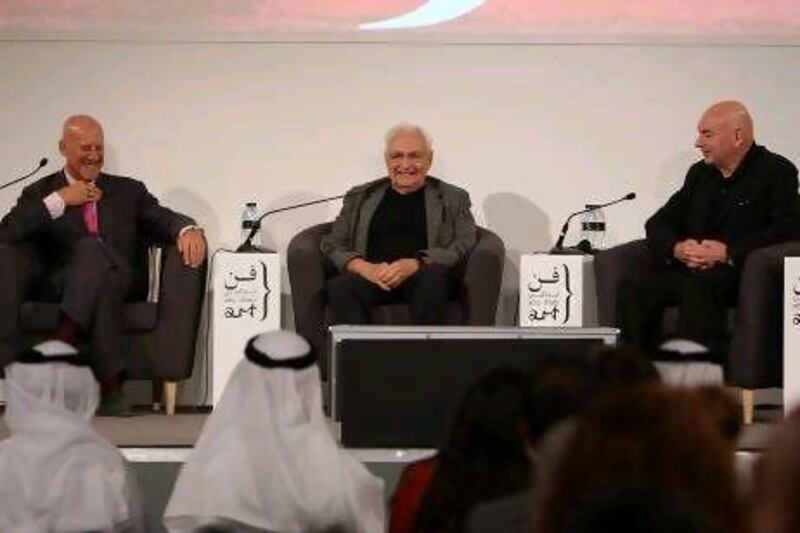ABU DHABI // The capital is at the start of a golden age, the world’s leading architects said last night.
"Everything is happening here," said Jean Nouvel, the Frenchman who has designed the new Louvre Museum on Saadiyat Island.
“I’m very proud to participate in the materialisation of this golden age, and this pushes us to go higher and beyond and further because we are doing something that the whole world is looking at.”
He was speaking alongside the Guggenheim Abu Dhabi architect Frank Gehry and Norman Foster, designer of the Zayed National Museum.
The three buildings will become Saadiyat’s cultural centre, and the three architects were at Manarat Al Saadiyat last night to discuss their work on the island and share their thoughts on their industry.
Gehry admitted to feelings of hesitation before taking on the Guggenheim Abu Dhabi project but said he was now glad he participated.
“I was hesitant because it was formidable to travel here,” he said. “At the beginning I thought it was going to be impossible and once I came I fell in love with the region. My friends here have done other work here. This is my first and only project in the region.”
He spoke of making an effort to understand the region, its culture, priorities and language. “Now I feel I have only scratched the surface. I wish I knew more and I want to know more and, as this goes forward, I will spend more time here.”
When asked about his thoughts on the legacy of the building, his response, said with a smile, produced a laugh from the audience: “I’m 83 now. I don’t know, I’m worried about whether they are going to finish in time so I can see it.
“I have been lucky though – a lot of buildings have made a difference in the cultures were they are built and I think this collaboration with the Emiratis has been very meaningful and I hope it results in a legacy.”
The architect told the audience he believed the Guggenheim was “the hope for the future” because the art that will be shown there will be collected from artists from all over the world.
Lord Foster, whose firm Foster + Partners is also the designer behind Masdar City, spoke of renewable energy and doing “more with less”.
He said: “What is quite interesting is you go there; the lights are blazing, it’s a very energy-intensive environment because it’s a laboratory complex devoted to a whole series of experiments about renewable energy. What is quite interesting is it is developing more power than it’s consuming and, in that sense, it’s totally solar and that’s exciting.
“I agree with Frank. I think it’s a great environment here. It’s very progressive. There are a lot of explorations.”
Jim Weier, a former architect who is now a lawyer in Abu Dhabi, arrived early at the event to ensure a seat. “It’s a massive thing having these three people in one room. Their architecture speaks for itself,” he said.
“The buildings are going to be three brand-new world icons and how rare it is to see the geniuses that created them all in one place.”
The three much-anticipated, innovative buildings will be the centrepieces for Saadiyat Cultural District, which is being built by thye Tourism Development and Investment Company on the 27-square-kilometre island.
The government-owned developer has been working on plans for the prestigious district since its inception in 2006 and it is one of its flagship development projects.
Abu Dhabi Tourism and Cultural Authority, which formed after a merger of the separate tourism and cultural entities this year, is the owner of the three museums.
Each will have its own particular draw for visitors. The Louvre Abu Dhabi, the result of an intergovernmental agreement between France and the UAE, will span the centuries and the globe, showcasing work from different civilisations and cultures, from the ancient to the contemporary. One of its main features is a 180-metre-wide dome.
The Zayed National Museum is being developed with the help of the British Museum. It will include five galleries, a library, educational facilities and a fine-dining restaurant.
It will honour the life and achievements of Sheikh Zayed, founding President of the UAE, and also celebrate the country’s rich heritage. In a dramatic, eye-catching design, five steel towers will shoot hundreds of metres into the sky.
The shape was inspired by a falcon’s wing and a falconry and conservation centre will highlight Sheikh Zayed’s favourite pastime, as well as his desire to make wildlife and land conservation one of the country’s top priorities.
Transnational contemporary art will be the focus of the Guggenheim. Visitors will be able to view work from Emirati artists as well as taking in masterpieces from the museum’s global collections.
It is designed to be the largest Guggenheim museum in the world and the only one in the Middle East. Eleven landmark cones are a distinctive feature of the building.
The construction of the museums has faced long delays. A new timetable for the projects was unveiled in January, promising they would be completed by 2017.
Abu Dhabi’s Louvre Museum is expected to be ready first, with an opening date of 2015. The Zayed National Museum will follow, throwing its doors open in 2016, and the Guggenheim will complete the world-class trio in 2017.
The Louvre and Guggenheim museums were initially expected to be finished by 2014, and the national museum later that year.
newsdesk@thenational.ae






